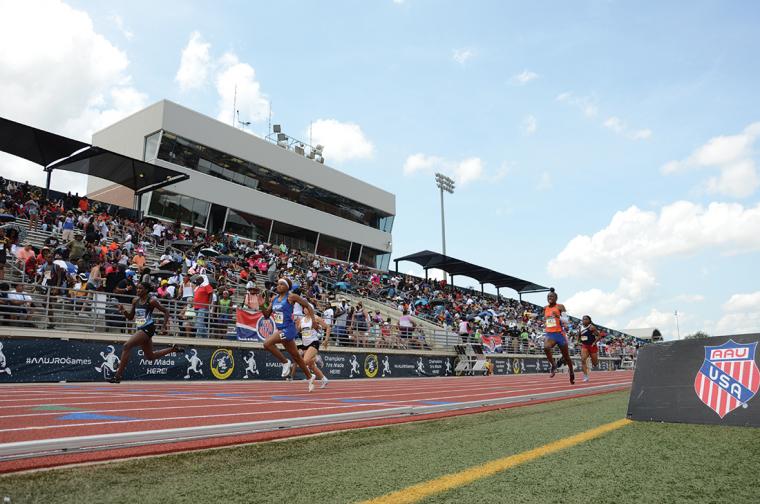
Sports are a catalyst of economic development and their relationship to a host city or organization should be diligently planned and managed if all parties are to derive optimal financial gains. Sports tourism encompasses traveling to a destination specifically for a sports-related activity (e.g., competition, educational program, recreation, adventure, or training) or to visit a sports-related attraction (e.g., museum, park, marina, exhibition, or athletic facility).
According to the State of the Industry Report prepared by the Sports Events and Tourism Association, sports tourism in the United States (U.S.) generated over $103 billion in business sales in 2019, representing a five-year annual growth rate of 5.9 percent since 2015. The spending was calculated according to direct expenditures ($45.1B – see Table 1), indirect expenditures ($25.4 billion), and induced expenditures ($32.8 billion).
Direct expenditures are those connected specifically to operational areas while indirect and induced expenditures comprise all outputs required to support operations (the ripple effect) such as communications, construction, utilities, agriculture, etc. The 2019 report, which excludes spending on professional sports (e.g., NFL MLB, etc.) and regular collegiate season games, calculated $14.6 billion was accrued in personal and corporate taxes including $6.8 billion designated for local and state governments.
Table 1: Annual U.S. Sports Tourism Direct Expenditures (2019)
CATEGORY EXPENDITURES
Transportation $12.5 B
Accommodations $9.2 B
Food & Beverage $8.6 B
Entertainment $5.7 B
Retail $5.1 B
Tournament Operations $3.9 B
TOTAL $45.1 B

Executives from convention and visitors bureaus, destination marketing organizations, sports commissions and area chambers of commerce contributed to the 2019 State of the Industry report, noting accommodations represented approximately 20 percent of U.S. sports-related travel spending during the year with 69 million room nights allocated. Almost 411,000 full-time employment positions were a result of sports tourism events in 2019.
In terms of events serving as the primary driver of sports tourism, the greatest benefit for a city is realized through regional-level coordination and cooperation. Meredith Scerba, former Senior Vice President of Marketing and Operations for the Greater Cleveland Sports Commission (GCSC), knows the value of cooperative efforts. Scerba served as the executive director of the 2013 National Senior Games in Cleveland, Ohio which involved 19 sports for 10,881 athletes age 50 and up, and generated $33.1 million in economic benefits.
Scerba also served a two-year temporary position in Sarasota, Florida as the executive director of the 2017 World Rowing Championships. The international event generated $22.6 million in economic benefits and included 930 athletes representing 68 countries who competed over nine days. The rowing event also included 1,900, volunteers, 320 credentialed media, and 6,544 foreign spectators.
Scerba advocates that the most economically attractive sports events are those that cater to older and wealthier visitors, such as the World Championships. However, regardless of whether a sports tourism event is complex, attracting global interest, or a relatively low-key regional event, organizers are responsible for ensuring effective operations; emphasizing participant safety; and achieving organizational goals which typically correspond with revenue generation. In respect to the general goal of revenue procurement, Scerba recommends the following five strategies to leverage the economic impact of sports tourism:
Operate through an Effective Organizational Structure

The likelihood of exceeding monetary goals for a sports tourism event is increased when operations run smoothly and accountability is tied to project or task completion. Accountability begins with a well-designed organizational chart that defines the working relationships among individuals and committees. The organizational chart is one of the most important documents driving planning, operations – and consequently, the results of an event.
The structure refers to the system or framework of connections and reporting lines between individuals (staff, directors, ambassadors) and groups (e.g., departments or committees). In addition to the emphasis on accountability, a well-designed organizational structure clearly defines lines of communication while remaining flexible to allow for growth and adaptation in the face of unforeseen circumstances. For most sports tourism events, the organizational structure represents the individuals comprising a local organizing committee responsible for the primary logistics, entities responsible for operational tasks and peripheral stakeholders who have a support function such as an international or national sports federation, first responders, or government liaisons.
Event organizers generally operate under the mantra that “the key to success is planning and the key to planning is anticipation.” Successful management of sports tourism events is predicated upon planning and operations that foster cooperation and collaboration among all the stakeholders which include government (city) and business leaders representing the location destination and the individuals associated with the actual sports activity (e.g., officials, athletes, volunteers, etc.).
The organizational structure clearly identifies each stakeholder or stakeholder group and their respective operational function. It identifies committees, event chairs, and ambassadors who are typically local leaders that are best able to influence fundraising and drive interest and commitment. Effective staff management and operations are facilitated by well-designed job descriptions that align with each position within the organizational structure. The potential for an event to maximize revenue streams is realized through the efficient and effective coordination of the individuals and committees fulfilling the responsibilities outlined in their job descriptions.
Create Ancillary Events
According to Scerba, the best means to leverage the economic impact of a sports tourism event is to create alternative revenue streams derived from ancillary events. Ancillary events positioned around the main event provide additional opportunities for partner activation and exposure. They are also a means to enhance fan connectivity.
The 2017 World Rowing Championships, for example, featured a Fan Fest, stage concerts, a series of local eco-tours, a “Row for the Cure” race, a fashion show and an adopt-a-team youth education program. Merchandising, parking, concessions, food trucks, pop-up stores, photo booths and carnival rides or games are all ancillary operations with spending implications.
Ancillary events may also include trade shows, galas, awards ceremonies, educational conferences, instructional clinics, training demonstrations, test events, staged competitions for specific populations (e.g., youth or those with physical or developmental challenges, for example), opening and closing ceremonies for the main event, athlete villages or meet and greets.
These ancillary events are a source for garnering additional income while also serving as a tool to enhance the value of the tourism experience for athletes, spectators, and sponsors. Staging ancillary events before and after the main event can also impact the length of an individual’s travel plans resulting in increased spending on accommodations and meals in the host city
Create Brand/Legacy Programming Emphasizing Local Partnerships
To truly leverage the economic impact of sports tourism, especially associated with a mega-event, Scerba advocates the creation of legacy programming that can be delivered at least a year prior to the main event and sustain well after its conclusion. Leading up to the 2013 Senior Games, for example, “the Year of Vitality” slogan was linked to 111 community events staged in and around the vicinity of Cleveland.
The legacy programming, some which fall under the definition of “ancillary events,” included the opening and closing ceremonies, a beach party, a volunteer appreciation party, parades, panel presentations and other fan activities. These programs provided a forum to showcase the Senior Games’ 78 event specific partners by featuring community sponsors, media outlets and booth patrons representing local organizations.
Legacy programming serves as a prelude to the main event, allowing organizers to build anticipation among the public; however, the primary value of a legacy program becomes apparent if it results in measurable outcomes such as an increase in tourists or attendance at area venues and attractions. A protracted increase in tourism and attendance can add to long-term job growth and tax benefits for a destination while also contributing to building a stronger city brand. The key for organizers in creating brand legacy programs includes a focus on building relationships with the local community by partnering with key government and business leaders to localize decisions and provide partner assets.
Develop and Promote Tourism Packages
Scerba believes the promotion of tourism packages can leverage the economic benefits for the host city while adding to the overall destination experience sought after by travelers. According to the 2019 state of the sports tourism industry report mentioned earlier, overnight travelers spent an average of $359 per person per trip compared to an average of only $79 spent by day trippers.
It is therefore logical that local organizing committees should make every effort to create tourism packages that feature accommodations and entertainment options. The promotion of established tourism packages is a prime opportunity to leverage partnership relationships with local sponsors. Scerba emphasizes that local organizers must clearly understand visitors seek easy, accessible, turnkey accommodations and experiences. Ideal tour packages are those that save the visitor time and money in planning.
Organizers benefit by creating packages that appeal to their targeted audiences such as families, athletes, solo travelers, adventure seekers and culturally motivated travelers. Packages should outline the cost and accessibility for admission to the main event, accommodations, ground travel, meals, recreation or entertainment, as well as any special events. A pick menu option provides convenience and flexibility sought after by travelers. Lastly, organizers are provided some peace of mind by knowing that guests who secure a tourism package are less likely to cancel plans.
Design & Implement Strategic Marketing and Recruitment Activities
To truly maximize revenue from sports tourism, Scerba believes events should be heavily marketed and campaigns carefully designed and executed to reach targeted sponsors (partners), participants and spectators. A unique selling proposition, the creation of ancillary events, and promoting key benefits are essential marketing activities. Additionally, heavy promotions (e.g., discount coupons, onsite rebates, samples, etc.) are often needed to drive participation and visitor numbers. Additionally, organizers must be aware of their high spenders and heavily market to this influential group. For example, the organizing committee for the 2013 Senior Games hosted a two-day calling campaign involving every staff member to invite a list of several hundred handpicked individuals to attend the multi-sport festival.
After highlighting the selling points of Cleveland and explaining what visitors would experience, the committee converted 25 percent of the sales calls. Advertising for the Senior Games featured 80,000 print brochures, three static and two digital billboards, 87 pole banners, six rail banners, 11 kiosk displays, 75 taxi toppers, and 56 summer festival appearances. The World Rowing Championships, meanwhile, concentrated on varied themes to grow the number of daily visitors such as a Family Fun Day, Tech Day, Farmers Market Day, Military and First-Responder Appreciation Day, Golden Ages Day, Boating/Fishing Day and a Health & Wellness Day.
The Cumulative Effect
Post-event reporting where the primary purpose is showing accountability and transparency is important to measure the impact of the main and ancillary events associated with sports tourism. A detailed audit, preferably by a third-party accounting agency, is recommended to truly realize the economic impact of the cumulative activities comprising a sports tourism experience. Additionally, producing a model or template of the reporting mechanism assists in measuring the viability of future tourism opportunities.
Event organizers who engage in intentional planning are likely to reap the financial rewards associated with these recommended strategies to leverage the economic benefit of sports tourism. Event hosts are also aware that beyond the monetary benefits of sports tourism are opportunities to achieve important subsidiary goals for a city such as enhancing the image of a destination or event and developing community pride. SDM


